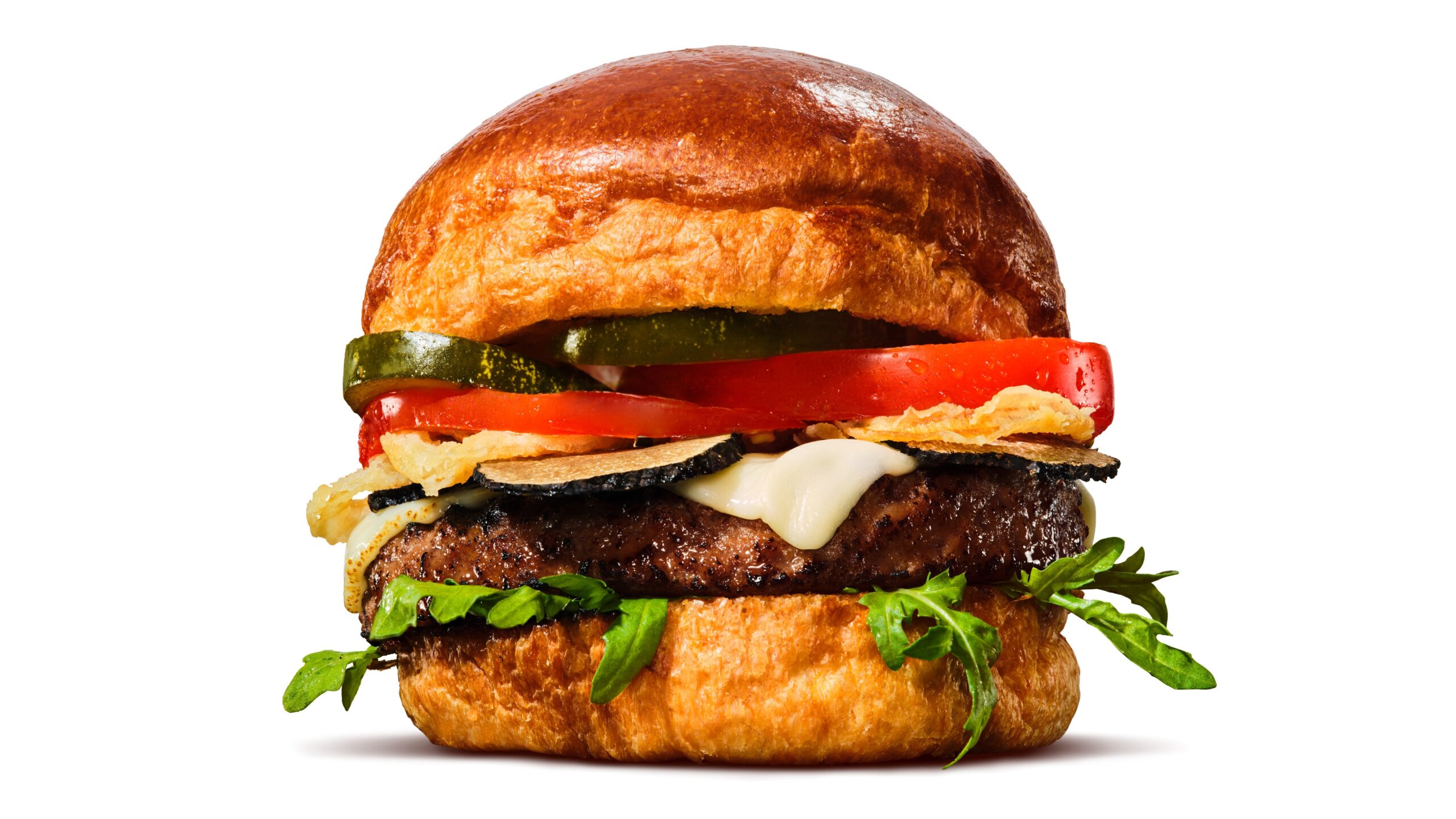In 2016, after five years of research, Impossible Foods launched a plant-based burger that “wasn’t your vegan friend’s garden patty.” Founder Pat Brown wasn’t interested in selling it to vegetarians, he once told CNBC, but to “the hard-core meat lover.” A feat of biochemical engineering, the Impossible patty handled like ground beef, sizzled on a hot grill like flesh, even “bled” the way juicy burgers are supposed to. It was convincing enough that within three years of its debut, every Burger King in the country was serving an Impossible Whopper.
Impossible’s latest creation continues the crusade to convert dedicated carnivores: This summer the brand revealed the Indulgent Burger, its “juiciest, beefiest, thicccest” offering yet. It shares a virtually identical lineup of ingredients with the original quarter-pound patty, but the new formula is designed to maximize the burger’s beefiness. The Indulgent is heftier than its predecessor (⅓ of a pound versus ¼), and contains more salt, as well as more than twice the amount of fat. According to Impossible, 82% of its early tasters said that the Indulgent Burger tasted “as good as or better than ground beef from cows,” while one Fast Company writer described it as not just the first plant-based burger he “really enjoyed,” but a potential “game changer” for the entire plant-based meat category.
Recently, I slathered some bouncy burger buns with mayo, fired up my hottest burner, and tossed a pair of patties into a pan. Little white globules of coconut oil, intended to simulate natural marbling in meat, melted and sputtered. I wrinkled my nose as the sharp, metallic smell of Impossible’s not-at-all-secret sauce, heme—a molecule found in meat that the company produces using genetically engineered yeast, and which is responsible for the patties’ signature color, smell, taste, and tendency to “bleed”—filled my typically vegetarian kitchen. After a few minutes on each side, the exterior, originally the color of watered-down cranberry juice, had caramelized into a dark brown. As I loaded the burger into the bun with lettuce, tomato, a round of red onion, and a yellow square of American cheese, I forgot for a moment that I was about to eat a combination of soy protein, vegetable oil, methylcellulose, and cultured dextrose.
Impossible’s beefed-up burger lands at a moment when fortunes have flipped for purveyors of faux flesh. After years of flying high—billions of dollars in investment, numerous high-wattage celebrity endorsements, and distribution across tens of thousands of restaurants, grocery stores, and fast-food chains—sales of plant-based meat as a whole have been either stagnant or falling since 2022. Impossible and its chief rival, Beyond Meat, have both laid off roughly 20% of their employees in the past year. Of course, critics of the cow-less burgers are gloating.
I sliced my burger in half, revealing its layers: a brown, seared crust and a pink, fleshy middle—what one expects to see when they bisect a burger. Taking a bite, the tug and tear of the patty felt uncannily like ripping into muscle fibers. Salty juice sputtered out with every bite, soaking my bread. It’s definitely…meaty, I thought. Flavor-wise, it tasted much like the brand’s standard burger, only bigger, oozier, and richer; a touch more like beef. If I hadn’t experienced the flavor of real animal flesh before—intensely savory, gamy, and a little bit sweet—I might not have known the difference. The Indulgent was so honkin,’ in fact, that it overpowered my sweet summer tomato, crisp lettuce, and velvety, piquant cheese. Some people are going to love that.
Ultimately, the Indulgent Burger was too beefy for me: I’ve always preferred a thinner patty, and I’m all about the bean-and-grain burgers popularized in the ’80s.
Veg-dominant eaters like me are supposedly not Impossible’s target audience, but sales data paint a different picture: “Plant-based meat’s most reliable enthusiasts at this point are those original veggie burger stans, vegans and vegetarians,” Bloomberg Businessweek noted recently. “The all-important meat eaters do partake, but at a much lower frequency.”
The Indulgent Burger doesn’t seem poised to solve that problem, either: It wasn’t similar enough to meat for my boyfriend, an omnivore and presumably the target of this new, ultra-beefy patty. For him, it was still missing some key factor that makes meat taste like, well, meat. Flesh? The cow’s diet? “A certain…je ne sais quoi,” he said. “The texture of meat is still a little different.” (He is not a professional food critic.) At a restaurant, faced with a choice between Indulgent and real meat, he would definitely order the classic beef burger.
It’s totally plausible that products like the Indulgent Burger will get some people to eat a bit less meat some of the time; fake meats are “perhaps a necessary stopgap” on our way to decentering animal products, Alicia Kennedy, the food writer and author of No Meat Required, told WNYC in an interview. And sure, I would totally smash an Indulgent Burger with fries and a beer after a long day on the slopes if it’s all a restaurant has. (I’ve also been known to voluntarily throw a diced Impossible sausage into minestrone for a little flavor boost.) But it’s pretty clear that the myriad sausages, flesh pink burgers, and vegan chicken nuggets shaped perplexingly like turtles and whales haven’t quite found their place in our freezers.
So, if not these tech-spawned facsimiles, what do people want if they don’t want meat? Surprise, surprise: It’s vegetables. I will always opt for a bun stuffed with fall-apart summer squash and fried halloumi over a processed disk masquerading as animal flesh (no, I’m not participating in psyops). Eaters of all stripes are craving patties made of recognizable plants, like those detailed in Lukas Volger’s hit cookbook, Veggie Burgers Every Which Way, or the visibly vegetably mushroom and sweet potato number recently rolled out at Shake Shack. Even meat eaters stand in snaking lines for hours in the heat for a veggie burger from New York City’s cult-favorite Superiority Burger, which uses quinoa, carrots, chickpeas, and spices in its coveted recipe.
As I write this, I have a box of Actual Veggies burgers sitting on my doorstep. For lunch, I’ve got my eyes on the purple one: It’s made with beets, carrots, navy beans, red and yellow onion, quinoa, oats, chickpea flour, lemon, and a bunch of spices. It may or may not be the tastiest burger I’ll ever eat, but it sure won’t be the meatiest.





